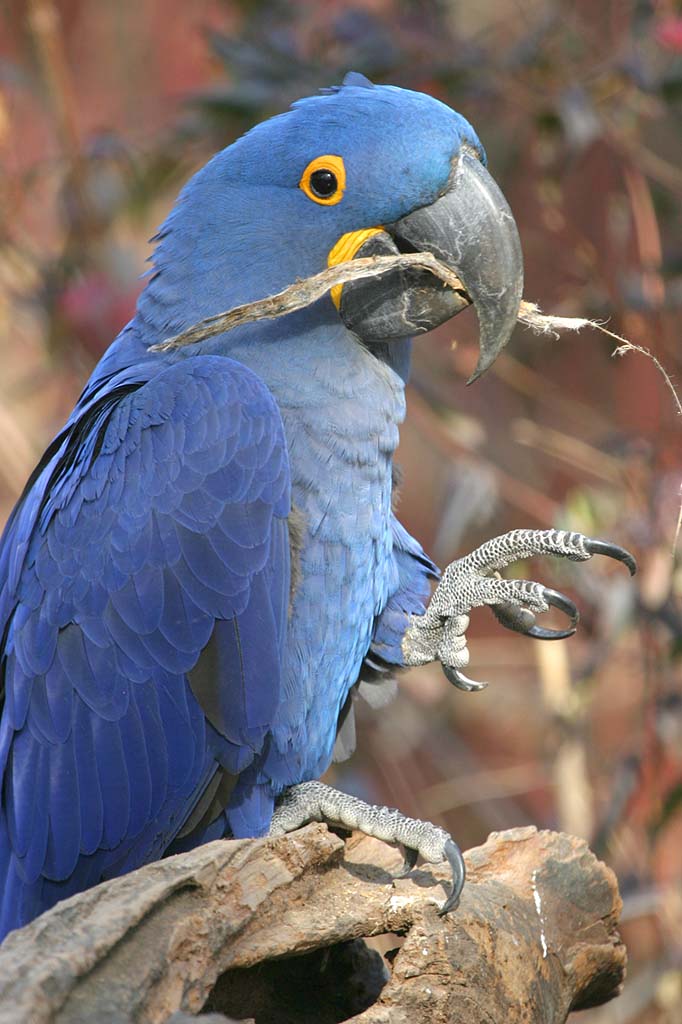Hyacinth Macaw (Anodorhynchus hyacinthinus) - Wiki Hyacinth Macaw
From Wikipedia, the free encyclopedia
The Hyacinth Macaw (Anodorhynchus hyacinthinus) is the largest macaw and the largest flying parrot species in the world (however, the flightless Kakapo of New Zealand can weigh up to 3.5kg making it the heaviest). Their unique size, color, and markings make the Hyacinth Macaw one of the most recognized species of macaw. Their popularity as pets has taken a heavy toll on their population in the wild. Expect to pay between $9,000-$12,000 US dollars for a pet.
These birds grow to a total length of 100 cm and weigh 1.4-1.7 kg. The wingspan is 130-150 cm. They have a beak pressure that can easily disassemble the bars of a welded wrought iron cage in a short time. This powerful beak is ideal for its favorite foods, which include hard nuts and seeds that would otherwise be inaccessible. Their strong beaks are even able to crack coconuts. In addition, they eat fruits and other vegetable matter. Pine nuts are also one of the most popular foods. There are eight species of palm that are central to their diet. They are generally messy eaters.
The Hyacinth Macaw has a solid blue body of feathers, similar to the color of indigo. It has a solid black beak with bright yellow along the sides of the lower part of the beak and circling its solid dark eyes. Unlike other species of macaw, it does not have a white patch of featherless skin around the eye. The female and male are nearly indistinguishable, although the female is typically a bit more slender.
These birds nest in existing holes in trees. The clutch size is one or two eggs, although usually only one fledgling survives as the second egg hatches several days after the first, and the smaller fledgling cannot compete with the first born for food. Juveniles stay with their parents until they are six months old. They are mature and begin breeding at seven years.
The Hyacinth Macaw survives today in three known distinct populations in South America: southern Brazil, eastern Bolivia and northeastern Paraguay. It is possible that smaller, fragmented populations occur in other areas of its range. Its habitat includes riverside tropical rain forests and palm swamps.
Bird experts often advise those interested in obtaining a macaw as a pet to educate themselves extensively about these birds prior to obtaining one, as these animals require more attention than a dog or cat and they are not considered domesticated animals by the official definition. It is illegal to import macaws into the US and Australia and only birds born in captivity are legal for sale in these countries. If you live in other countries please check your local regulations but be aware any purchase of imported macaws hastens the species extinction in the wild.
The Hyacinth Macaw is considered an endangered species due to overcollection for the cage bird trade and by the use of their feathers by the Kayapo Indians of Gorotire in southern Brazil. These Indians use the feathers to make headdresses and other baubles for the tourist trade. Also, like many other animals, their habitat is being reduced by development. Annual grass fires set by gauchos can destroy nest trees.
http://en.wikipedia.org/wiki/Hyacinth_Macaw
| The text in this page is based on the copyrighted Wikipedia article shown in above URL. It is used under the GNU Free Documentation License. You may redistribute it, verbatim or modified, providing that you comply with the terms of the GFDL. |
